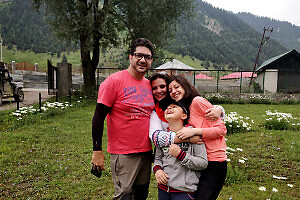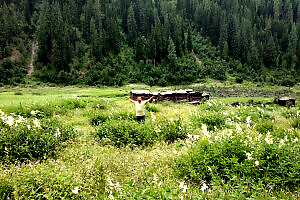
views
The loops of razor wire, taller and twitched than before, run for miles along the streams and woods of pine and birch trees as our cars pull through the dirt tracks of Tilel, in Bandipora district of north Kashmir.
It is a thrill for the 12 car racers, on way to Gurez, and an unusual sight for residents of 30-odd villages. They rarely get to see a trail of vehicles going past the rock-and-mud stretch near the Line of Control, more than 100 kilometres away from the capital city Srinagar.
Ali Sajid, the team leader is a calm man but temperamental on the wheel. His wife Farah Zaidi is an extrovert and a real bundle of energy.
Two years ago, the couple founded ‘Kashmir Off Road’ - valley's first car racing club that now boasts of three dozen members. Every month, the members drive to far-off and untouched areas of Kashmir.
Ali has organised several rallies and also introduced Kashmir to its first woman car racer. Sharmeen - a medico and mother of three- drove to snow clad Gulmarg.
Ali and Farah complement each other well and have more in common than contrast. Both are crazy about cars and expeditions. Farah handles the club’s PR.
"They love the smell of mobile oil and diesel and the roar of the engines," one of their friends says. The two got married a decade ago and have been blessed with a boy and girl.
Before getting married, Ali was doing well in Dubai and Farah had just completed her studies. They met on the wedding of Ali's sister who was Farah's university friend.

Ali Sajad poses for camera with his wife and children in Gurez
"I attended the function in Srinagar. I guess his family liked me. They brought the proposal to us. We got married without much song and dance," she recalls.
Last weekend, the couple, their two kids and 28 friends were on the uncharted Gurez-Dras route, trying to cross the strategic Koabal Galli that would have given us a peek into the mesmerising Mushkov valley.
But the cars - some modified to make lot of noise and show - had to pull up at the last village Chakwali before the real ascent could have begun. A huge mountain mass had snapped the link to Dras.
With only 90 minutes or roughly 37 km of drive left to hit Dras, it came as a huge disappointment. From Dras, the members had planned to take the Zojilla Pass to reach Srinagar from where they had started 36 hours ago to do an almost impossible maiden circuit.
"Maybe next year, or in two years we can do it," shouts Shafat Majid, an avid car racer, betraying his displeasure. Majid, a pharmaceutical businessman, says that he was passionate about cars and driving along treacherous roads since teenage.
"I got my car recast in Delhi. I spent additional five lakh on its engine, tyres, make up," he adds.
Aqib Bhat, a young journalism student, too is fond of driving but doubles up as club’s photographer. "We get to explore gorgeous places. Others would find it difficult to access these villages," he beams. "We are lucky."

The beauty of the valleys and its fragrant high grasslands and the bouncy Kishenganga and Burzil streams somehow make up for the tiresome journey.
Luck, stamina, patience and sturdy cars to negotiate the wobbly tracks are required if you are driving through the stretch.
But the discomfort of snaking roads along mountains is worth it. The beauty of the valleys and its fragrant high grasslands and the bouncy Kishenganga and Burzil streams somehow make up for the tiresome journey.
The 70 km stretch to Gurez throws up some amazing scenery and villages that appear as landscape paintings of green blades, blue skies and foamy waters. And the unassuming Shina-speaking community called Dards. They have a distinct culture which is closer to those living in Gilgit across the LoC.
The Dard women labour with men in fields, collect herbs, vegetable leaves and firewood in the jungles and then cook on flame for hours for their families.
And kids, for instance in Gujran village, have erected a wooden block for stumps and a raw club for a cricket bat. They play on a piece of land between a gushing stream and an unending razor wire that runs for miles. The Indian army which is all over the villages and atop hills maintains a tight vigil as the place lies close to the LoC.
At other places the jubilant boys chase cars when you slow down while crossing a stream or a mud track.
Barring the four months of potato, pea and cumin cultivation, the men remain jobless for most part of the year.
For the rest of the season, they move to cities for work. The region remains cut off from the rest of the world for nearly seven months due to 6 to 15 feet deep snow that buries the concertina wires and partially the houses made of wooden logs, rough planks and thatch.
Despite the oddities of not enough work available or no good schools or lack of phone and transport connectivity, the villagers have only one grouse; they want the Dras route to be thrown open.
"The locals can set up shops and shelter homes for tourists. This will generate work for youngsters," says a villager.
But an army officer told News 18 that road link won’t be opened for tourists for next few years due to strategic reasons. "The stretch lies perilously close to the LoC. The weather is also a big impediment.’’
The fear of economic activity and as a result of construction can hit the fragile ecology of region. Dawar, the headquarters of Gurez and Tilel, is already being cited as a bad example.
Dawar’s picturesque landscape has today turned into a dockyard of metal and scrap. Heaps of iron railings, tin, rocks and brick that dot the last 15 km stretch from Kanzalwan to Dawar have ravaged the otherwise virgin picnic resort.
A 22 km tunnel inaugurated earlier this year and a huge dam dug up as part of an ambitious 330 MW hydropower project has further messed up the ecology of the place.
The water level of the dam is rising and has already swamped six villages. More than 30,000 trees were felled to construct the dam. Some 250 families have been displaced and many more would add up to that list in coming years. The dam would be filled up with 40 feet deep water to create the gush for power generation.
The tunnels (there are more than one), dam, the fence and other assortments have turned Gurez ugly.
Villagers want Gurez and Tilel to be remembered as great health resorts and great adventure destinations.
"There are lot of trekking routes. The best one will take you to Razdan pass - the highest point on Srinagar-Gurez highway. The second best is Tilel through its many mountains," says Abdul Aziz Lone, an engineer with Public Works Department. The landscape is apt for mountain biking, hiking and rafting.
The Gurez valley has 67 villages and each competes with other for the incredible fragrances and sights. Some 30,000 residents live here in the summers but only one-sixth stay in winters braving the snows, avalanches and sub-zero temperatures. Those who want to get in or out of place use chopper services because the road link remains snapped for seven months.
"We have time and again asked for a tunnel and a reliable road link to the place but that is not happening. During winters if army or locals are trapped in an avalanche there is no route to carry out a rescue," rues Nazir Gurezi, the three time local MLA.



















Comments
0 comment